#Methodology
Explore tagged Tumblr posts
Text
Yep yep, you're totally understanding right. (And if I hadn't been in such a rush when sharing this, I might have explained that, or shared the following... glad to come back and expand on it now!)
SPOP and Catradora show up very high on the lists when we look at some of the other graphs:


In previous versions of F/F stats, I had shared these two graphs in the main post. But people had reasonably pointed out that a lot of the ships on this list (e.g., Marlene/Dorcas) are often background ships for M/M or F/M ships -- and a lot of the fandoms that allegedly have the most F/F also frequently have background F/F.
Folks wanted to know which ships and fandoms had the most F/F if you only focused on the works where F/F is foreground -- but unfortunately, there's no way to do exactly that, because AO3 doesn't tell you which ship(s) or category(/ies) are the main ones, when there is a hierarchy. All I can see is which categories the author has tagged, not which are most important. As a result, it's like you said -- when I also pulled data on F/F and removed all works that also had tags for F/M and M/M, I removed a lot of Catradora works and other works that were genuinely about F/F.
There is, of course, no perfect set of data; there are just pros and cons of different data sets. But it's fantastic to see a bunch of newer F/F ships (at least compared to when I started these stats back in ~2013, lol) like Catradora that are genuinely huge without mostly appearing as background ships! <3 And Catradora is one of the ships where it's most reasonable to look at the overall F/F ships graph (without filtering out the F/M and M/M) because that fandom seems to have so much genuine multishipping that isn't putting the F/F in the background (maybe a bunch of that even has the F/M ship in the background; not sure). I'm guessing that's true for a lot of the bigger ensemble shows where one of the biggest ships in the fandom is F/F, but where not all the main characters are female (contrasted to the K-pop bands or a show like Yellowjackets, where almost all the ships are F/F, so filtering out other categories doesn't change as much).







Toastystats: F/F stats (Feb 2025)
Happy Femslash February! <3 I have new stats about big F/F ships and F/F-heavy fandoms on AO3. For more data, explanations, and clarifications/corrections, please click through to AO3.
376 notes
·
View notes
Text
NAG NAG NAG [ATTIC DEMO] CABARET VOLTAIRE | 1977/78
59 notes
·
View notes
Text


#least liked brands#2024#ranking#list#survey#information#companies#united states#data collection#methodology#Trump#Musk#Twitter#Fox#reddit#Sheim#Tik Tok#Exxon#Comcast#Dollar Tree#Temu#Boeing#Dollar General
25 notes
·
View notes
Text






25.09.2024 🎈
day 2,
well well well, i didn't do much today but hey, slow progress is still progress right? RIGHT?
i'm gonna try to finish up the chapter i started today before going to bed.. so i can wake up all motivated to start a new one tomorrow inchaAllah.. (remember, fake it till you make it xD, i'm faking 'the motivation' hehe, but hey you know what? i don't really think i'm faking it anymore :O?? i do feel motivated!! :O *wink*)
btw i think i love 'Méthodologie' , it makes me use my brain, i actually did enjoy what i studied today, but i have so much more left T^T.. well, i could've had many more things done today, if my auntie and lil cousins hadn't thrown me a surprise birthday party 😎!
I am really so grateful for today, i had a really good time with my loved ones, Alhamdulillah for these little moments for they aren't little to me!
alright! see you! ^.^
oh wait i think i have more things to say..
that peach&passion fruit black tea tasted so good, and those beautiful toasts were a true delight! i also had a good shower, then put on a sheet mask my lil cousin gifted me the other day! and the cat you see in the picture is Shoyo, my buddy <3!
Alhamdulillah once again!
see yaaa! now i really have to go >.< !!
(ps: i think i have some sort of problem in my phone camera? i don't know maybe a stain in the inside of the cam?? it's not bothering me that much and i don't notice it all the time but today i did.. idk if you guys can see it but it's quite noticeable in the 'notebook' pic..)
9 notes
·
View notes
Text
17.05.24



The weather is nice again! I'm glad the rain definitely dampened my mood.
I spent almost the entire day in the library- found 'You will beat this essay' written on the cublicle wall, it gave me the motivation I needed to get a big chunk of my Lab reoprt done.
Today I;
Did the introduction of my lab report
Did the methodology of my lab report
Created the Figures for my lab report
Started to contact the study abroad students I will be travelling with
Studied social categorisation, stereotyping and prejudice
Studied intergroup relations and conflict
I went to the library and forgot my tablet, so I had to walk all the way there and alllll the way back.
#psychology#psychology student#psychology studyblr#university#study#studying#student#lab report#data analysis#statistics#stroop test#methodology#aesthetic#study aesthetic#chaotic academia#academics#college#social psychology
19 notes
·
View notes
Text
youtube
5 notes
·
View notes
Text

“The child, a free human being, must teach us and teach society order, calm, discipline, and harmony,” Montessori wrote. In some ways, the engine of her method was paradox: order is freedom, and vice-versa; the teacher is subordinate to the child, but powerfully so; a child must be left to her own devices, but left to them systematically, and the devices shall be made of wood.
[The New Yorker]
13 notes
·
View notes
Text
The Classics of Fan studies: Matt Hills - Fan Culture
The classic of fan studies I want to introduce today is a theoretical overview of the discipline from 2002. Indeed, in Fan Culture, Matt Hills explores the different theories of fan culture and the methodologies that had been used by scholars before him.
I particularly like the first chapter in which Hills challenges the idea that there is a dichotomy between passive consumers and resistant fans:
“Conventional logic, seeking to construct a sustainable opposition between the ‘fan’ and the ‘consumer’, falsifies the fan’s experience by positioning fan and consumer as separable cultural identities.”
In this chapter, he demonstrates that fans are also consumers and that depicting them as a separate group ignores the complexities and multiplicities of fandom.
While I found this book compelling, I would only recommend it to people who have read some fan studies works already as it might be a bit complex as a first introduction to the subject. However, if you are interested in fan studies theory and methodology, this is the book for you!
20 notes
·
View notes
Text
My Personal Methodology for Divination Reading
I will start by saying that every individual is different, and so the methods for one person almost certainly won't ring true for all people, but I'm going to do my best to cover what I believe are the most important aspects of my own divination methods.
1. My Tools are Only Tools
While I care deeply about the quality and care of my divination tools (my rune and ogam sets) at the end of the day they are mearly the tools I use to see the 'tapestry' of the future, or present in some cases. My tools may work a little differently (my ogam tends to lean more towards the emotional aspects of situations and speak in a more poetic fashion, while my runes tend to be pretty blunt and more straight forward) I don't personify them. THEY are not telling me what I'm reading, they are just the means by which I'm able to read.
2. Context is Key
Context when reading is absolutely EVERYTHING. The same stave could have dozens of different interpretations depending on the context of whats around it and the same 6 staves could have a dozen interpretations in the context of an individuals life. A reading discussing the persons ability to nurture and need to learn quickly could apply equally well to someone about to become a parent or someone entering a helping profession. Context is EVERYTHING.
3. Intuition is just as Important as Memorization
People tend to spend a lot of time and energy on memorizing the 'textbook' meanings of each tool that they're using. This is important because obviously you need to be able to speak the language of your tools in order to translate their meanings but I have been preforming divination for 10+ years and I ALWAYS have a quick reference on hand because KNOWING what is being said is more important practically than having the book meanings memorized. This idea feeds back into context, because a staves true meaning in a reading is based on the context of the staves around it and no book can account for all possible contexts.
#divination#ogham#ogam#runes#tarot#blackcrowing#methodology#divination methods#divination methodology
12 notes
·
View notes
Note
Hi, I would like to know how to make a list of all the ships in a fandom on AO3. For example, I use the Tag Search on "Transformers - A Media Types", but it shows that Jetfire/Starscream is the most popular with 641, but it is actually only the 6th with 1074. Furthermore, it quickly drops to showing Relationship with a single digit when I know that there are dozens of Relationship with hundreds of Works! Why don't most Works appear? Do you know of a way to find All the ships of a fandom on AO3?
Hey! Sorry for the slow reply... I was traveling and then covid knocked me flat for several weeks. :P
So let's talk about AO3 Tag Search. In general, I'm very excited about recent improvements to this feature... There didn't used to be any way to find the top ships (or characters, or freeform/additional tags) across all of AO3. But now you can* by doing a tag search and sorting by uses (descending order):
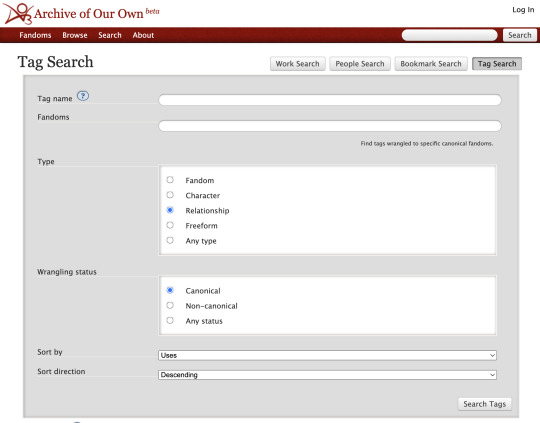
*In practice, though you won't exactly get a trustworthy list of top tags (and, as you pointed out, in some cases tags may even be missing! we'll get to that later). You will get a list where the numbers are not correct, sometimes to a bizarre degree:
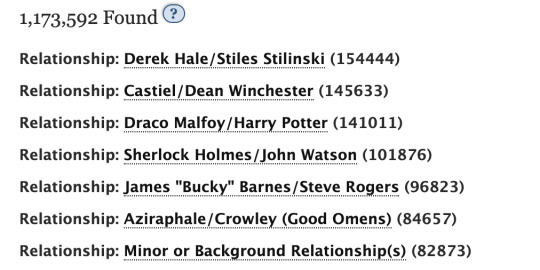
For example, when you click through on the Derek/Stiles tag, you find far fewer works using the tag (note that these are the public works -- if you're logged in, you see a somewhat higher number, but not as high as in the above screenshot):

I will be posting some stats soon that show different numbers (and a different order) for all of the above top ships. But why is there the discrepancy? Here are several guesses about why some works are wrong in Tag Search (and then I'll get to why some ships are missing and what to do about it):
TAG INFLATION #1: The above numbers probably include tags used in AO3 bookmarks, which increases some of the numbers quite a lot. [Evidence: if you search for top freeform tags, you get tags like "To Read" high on the list, and authors don't use those tags.]
TAG INFLATION #2: The above numbers seem to include draft works. [Evidence: I just tested this out by finding a rare tag with only one use... I created a draft of a new work using that same tag, and even though I didn't publish the work, Tag Search now showed 2 uses of the tag.]
TAG DEFLATION: The above numbers do NOT seem to take tag wrangling into account. Some AO3 tags have a lot of synonyms or subtags, but I think only exact uses of the tag get counted in the above list. [Evidence: I found at a tag with only one use according to tag search, but two works when I clicked the tag (Peter Gabriel/Mike Rutherford). I found that one of the works contained a synonym of the main tag ("Mike Rutherford/Peter Gabriel (Imagined)"). That would match with Tag Search only listing one of work for "Peter Gabriel/Mike Rutherford." And when I created a new draft work that used the main tag, it increase the count in Tag Search for "Peter Gabriel/Mike Rutherford" -- but when I created a new draft work that used the synonym tag, it did not.]
There may also be other factors affecting the overall Tag Search numbers.
Okay, so I suspect #3, tag deflation due to no tag wrangling, is (helping to?) create the unexpectedly low numbers you are seeing for ships like Jetfire/Starscream. I suspect that many people do not use the full canonical tag "Jetfire | Skyfire/Starscream (Transformers)", and those other uses don't get counted in Tag Search. The only way to address this issue is to click through on a tag returned by Tag Search and find out how many works the tag has once you look at its list of works.
But why aren't some ships showing up at all? That's a different question. Here, I suspect the answer again is related to tag wrangling. Every (?) canonical ship tag has at least one parent tag that is a fandom tag (as well as the relevant character tags). You can see the parent tags for Jetfire/Starscream on its tag page:
Skyfire (Transformers), Starscream (Transformers), The Transformers (Cartoon Generation One), The Transformers (IDW Generation One), Transformers (Bay Movies), Transformers (Dreamwave Generation One), Transformers (IDW 2019), Transformers (Marvel Generation One), Transformers - All Media Types, Transformers Animated (2007), Transformers: Armada, Transformers: Beast Wars (Cartoon), Transformers: Cybertron, Transformers: Cyberverse, Transformers: Energon, Transformers: Prime, Transformers: Shattered Glass, Transformers: The Headmasters, Transformers: War for Cybertron (Video Games)
Jetfire/Starscream has "Transformers - All Media Types" as a parent tag, and I suspect that is why it shows up in the Tag Search for that fandom. I would guess that some of the bigger Transformer ships do NOT have that broad fandom as a parent tag. Let's check the parent tags of Megatron/Optimus Prime:
Megatron (Transformers), Optimus Prime, The Transformers (IDW Generation One), Transformers (Bay Movies), Transformers Animated (2007), Transformers: Armada, Transformers: Robots in Disguise (2001), Transformers: Robots in Disguise (2015)
Megatron/Optimus Prime does NOT have "Transformers - All Media Types" as a parent tag. I suspect that's why it didn't show up in your tag search.
So what can you do? Unfortunately, I think the only way to be sure to find all the Transformers ships is to do a Tag Search within each of the different Transformers subfandoms (and I know there are a lot) and then combine the lists of ships you find for each. And then be sure to visit the tag works page for each resulting tag to get the actual number of works, as discussed above. I also discussed other ways to get the find the top relationships here, but I think they're all either less reliable or more arduous than this method, at least for a big fandom like Transformers.
Best of luck!
#ao3#ao3 tag search#ao3 search#tutorials#sleuthing#and speculation#asks#toasty replies#fandom stats#ish#toastystats#op#methodology#50
64 notes
·
View notes
Text
"
Introduction
Whether you’re aware of it or not, your engagement with Historical European Martial Arts is informed by a methodology. That is, the kinds of questions raised by our collective exploration of written sources related to swordplay have to be answered by historical inquiry. Historical inquiry can’t help but have a methodological construction, even if the person making the inquiry is unaware of it. Methodology is, pretty simply, the use of particular tools of analysis related to the goals of the analysis. To a historian, the goal of an analysis is to answer a historical question. For a historical fencer, the goal is likely something much more general.
The following article proposes a basic outline of the methodological approaches that are most visible among people in the HEMA community, whether they are individual fencers, club leaders, scholars, or otherwise. This outline is meant to be a tool and resource for fencers looking to make their practice and inquiry more meaningful. None of the following approaches or goals are considered more or less important than any other." An excellent article that aims to simply describe some of the methodologies in the historical fencing community, or as Brian Puckett wrote "
his schema is intended to be “descriptive,” not “prescriptive�� - aiming not to lay down recommendations for how fencers should approach their hobby, but to provide a framework to understand how people actually do approach their hobby." in his article 'Goals and Methodologies of Source-Use in Historical Fencing and Martial Arts' which you can find here.
Both articles found here in the HEMA World Domination facebook group.
21 notes
·
View notes
Text
Hi! Welcome to my music blog👋 I'm in the process of systematically rating, reviewing, and ranking the discographies of my favorite artists (because why not😂) and am focusing on The Beatles (including their solo careers). This sideblog is essentially just a place for me to write down all my thoughts about the process as I do it, so don't mind me as I ramble into the void!
If you're curious about what I'm doing, I've explained my methodology under the cut. I'm not a professional researcher by any means so it might be goofy but it works well enough for me. I have some music/music theory knowledge, but I don't pretend to be an expert on any of this. It started as an exercise to learn more excel formulas, and now it's just an excuse to listen to music as much as time allows.
Should be fun!🎸🎸🎸🎸
Methodology
For each song, I broke it down into 4 major categories:
lyrics
production
vocals
musicianship
I am giving each song a numerical rating for each category on a scale of 1-10 (1-awful, 10-perfect). I then average those numbers together to find the overall score for each individual song, and then these individual song scores are averaged together to calculate the score for the overall album.
In addition to the scores, I am also giving each song a rating, which is separate from the score and is determined solely by my reaction to the song, which reflects how much I like it, also on a scale from 1-10. The rating for each song is also averaged together to calculate the overall rating of the album.
So, the basic idea is, “Score” = how good is this song/album & “Rating” = how much do I like this song/album. There's obviously no way to fully remove subjectivity from the process, so my guess is the scores and ratings will end up being very similar. But I'm just curious to see if there's any meaningful differences.
In cases in which an individual song is determined to be especially influential or significant to popular culture/music history, a 0.5 bonus will be added to the song's score. The idea is to use this sparingly, but I thought that would be an interesting thing to keep in mind when thinking about the Beatles.
In addition to calculating the overall score, I am also calculating the “writing score” and “performance score” for each song (and averaging those together to find the writing score and performance score for each album). The writing score is found by averaging the lyrics and production ratings for each song. The performance score is found by averaging the musicianship and vocals ratings for each song.
My spreadsheet is generating numerous album and song rankings as I go. But the album score, album rating, individual song score, and individual song rating rankings are the four that I'm paying closest attention to.
Idk if any of that was clear to anyone other than me, so feel free to ask me questions!
** all scores are obviously subjective, and should be taken with many grains of salt considering I am not by any means a musical theory expert or professional musician. I am just a silly goofy gal who likes music and spreadsheets 🤙 **
Note: Only studio albums written primarily by (or for) John, Paul, George and Ringo are being evaluated for this project. Live albums and cover albums (such as John’s Rock ‘n’ Roll and Paul’s Run Devil Run and Kisses From The Bottom) were excluded. Some unique songs (by unique meaning not an alternative take/remix) from the Beatles' Anthology series will be evaluated for song rankings, but the Anthology albums will not be included in the album rankings.
2 notes
·
View notes
Text
In glancing over my notes of the seventy odd cases in which I have during the last eight years studied the methods of my friend Sherlock Holmes, I find maybe tragic, some comic, a large number merely strange, but none commonplace; for, working as he did rather for the love of his art than for the acquirement is wealth, he refused to associate himself with any investigation which did not tend towards the unusual, and even the fantastic.
"The Illustrated Sherlock Holmes Treasury" - Sir Arthur Conan Doyle
#book quotes#the adventures of sherlock holmes#sir arthur conan doyle#john watson#sherlock holmes#notes#passage of time#tragic#comical#strange#methodology#wealth#association#unusual#fantastic#the adventure of the speckled band
6 notes
·
View notes
Text
Class Feature Friday: Forensic Medicine Methodology (Pathfinder Second Edition Investigator Methodology)

(photography by drop-the-dagger on DeviantArt)
It is gristly work, but there is much that a body can tell us about the events that lead to their death if we know what to look for. Such is the basis of forensic medicine, and therefore, the subject we are looking at today.
The exact shape and results of a wound can tell the investigator what sort of weapon was used to make it, as well as anything unusual about it, while the presence of carrion insects can tell a lot about the time of death, and small marks and wounds might tell more about the exact circumstances that led to the deceased entering their current state. Imagine how this is extrapolated in a fantasy universe where a victim might show signs of unusual necrosis from a necromantic wound, or how they might show signs of extreme fright from a phantasmal killer spell, and so on.
While other investigators may be called in to examine the evidence of any sort of crime, today’s subject is almost exclusively expected to be investigating scenes of murder and death. However, their keen eye for detail can be used elsewhere, and their medical knowledge can also benefit the living. Such is the nature of their chosen profession.
In any case, this methodology might not have any fancy tricks like their counterparts, but with a little creativity and love of investigation fiction, it can be a perfect way to add some fun flavor to investigating, giving clues to upcoming foes.
With their training, these investigators have a knack for gaining additional details from examining cadavers. What’s more, they’re trained in medical practices, and able to heal themselves and others much more regularly through completely mundane methods.
That may be fairly basic, but there is one feats out there specifically tied to this methodology: Scalpel’s Point, which lets them use their knowledge of anatomy to strike for their foe’s arteries to cause bleeding.
Of course, other feats might prove useful for them as well, such as Flexible Studies, Known Weaknesses, That’s Odd, Ongoing Investigation, Connect the Dots, Predictive Purchase, Thorough Research, Whodunnit?, Reason Rapidly, Strategic Bypass, Reconstruct the Scene, and Just the Facts, though obviously some may be more useful to you depending on your build.
While not as flashy as other methodologies, being able to gain information specifically from the dead can be quite useful. What’s more, it’s unobtrusive, letting you dictate most of the rest of the build based on your own preference as well!
It’s a long-running trope that coroners and others that examine the dead tend to be… eccentric, to say the least. Often talking to the deceased or behaving in strange but otherwise harmless ways. If that fits what you’re going for with your character, then go for it, but don’t feel forced into it. Also remember that often in real life, forensic science is not always the foolproof method they portray it as in certain shows.
Exceptionally old for even a ghoran, Tender has watched friends grow up and die, while their own cycle of rebirth only briefly has interruptions. This has given them a fascination with the state of a body after death, which they’ve channeled into their investigative pursuits to bring murderers to justice.
A common method of disposing of bodies in the Red City is to feed them to the khefaks, a species of mineral-eating arthropods. However, the half-eaten body discovered in the pits shows signs of radiation poisoning, suggesting they were still alive when the radioactive specimen consumed them. Now the investigation turns to identifying the body and the sadist that doomed them to such a fate.
A recent string of serial murders has the city in an uproar, the only connecting factor being the method. The victims literally have their hearts ripped out by violent force, as if by an impossibly strong hand. Some has suggested a warrior bolstered by some potion of strength, while others think it might be some powerful wizard’s construct. Finding the truth will mean combing each killing for evidence.
#pathfinder second edition#investigator#methodology#forensic medicine#ghoran#khefak#Advanced Player's Guide
10 notes
·
View notes
Text
Etymological Map of America
— Alex | Vivd Maps
America’s rich tapestry of stories is woven into the fabric of its landscape, with many tales embedded in the place names of the cities and states. Understanding the meanings behind these names offers insights into the development of the land, its history, and its culture over the centuries. Not only does this deepen our appreciation of our surroundings, but it also enriches our vocabulary and occasionally aids in solving crossword puzzles, a sentiment strongly endorsed by WordTips.
Take, for example, Missoula, which translates to “River of Ambush” in Montana, evoking memories of inter-tribal conflicts. Similarly, Manchester, New Hampshire, derives its name from “Breast-like Hill,” harking back to the voluptuous mound upon which a Roman fort was constructed around 79 CE in Manchester, UK. Centuries later, Samuel Blodget, inspired by the barge canals of the British Manchester, spearheaded the construction of similar waterways in his New Hampshire town and suggested adopting its namesake.
But what about the rest of the U.S.? Armed with our etymology hats, we delved into dictionary country, scouring sources such as the Bureau of Indian Affairs, the Online Etymology Dictionary, the Encyclopedia Britannica, the American Library Association, and regional news reports. Our quest uncovered the literal meanings behind the names of each U.S. state, its capital city, and 178 of America’s largest cities.
Literal Translations of State Names and Their Capital Cities Across the U.S.
Names sometimes transcend boundaries. Both the state of Kansas and Kansas City, MO, derive their names from the Kansas River, which, in turn, honors the Kanza tribe, translating as ‘People of the Southwind.’
Interestingly, there exists a lesser-known Kansas City within the state of Kansas itself. This city adopted its name from its Missouri counterpart, hoping to leverage the fame of the Missouri town. According to local history teacher Matt Beat, “KCK wanted to capitalize on the success of KCMO and essentially mislead visitors into believing they were in the authentic Kansas City.
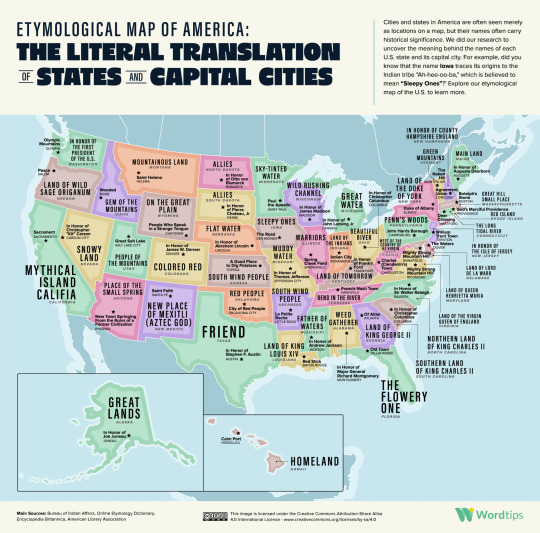
While numerous state names honor Native history or describe geographical features, others carry traces of colonial influence. The Carolinas, for instance, owe their name to King Charles II and his father, Charles I. The territory was initially chartered by Charles II, who bestowed the name in honor of his father. Additionally, the capitals of both Carolinas pay homage to European explorers, with Sir Walter Raleigh and Christopher Columbus lending their names to these cities.
The Literal Translation of Major City Names in the Northwestern U.S.
In addition to the straightforward meanings of city names like ‘Anchorage’ (a place suitable for anchoring) and ‘Portland’ (land surrounding a harbor), the Northwestern U.S. boasts some lesser-known etymologies, both of Native and settler origin.
Honolulu, for instance, derives from the Hawaiian language: ‘hono’ meaning ‘port’ and ‘lulu’ meaning ‘calm.’ Interestingly, the name traces back to British Captain William Brown, who initially named the port Fair Haven upon his arrival in 1794. Before this, Hawaiians referred to the area as Ke ʻAwa O Kou, meaning ‘the harbor of Kou.’
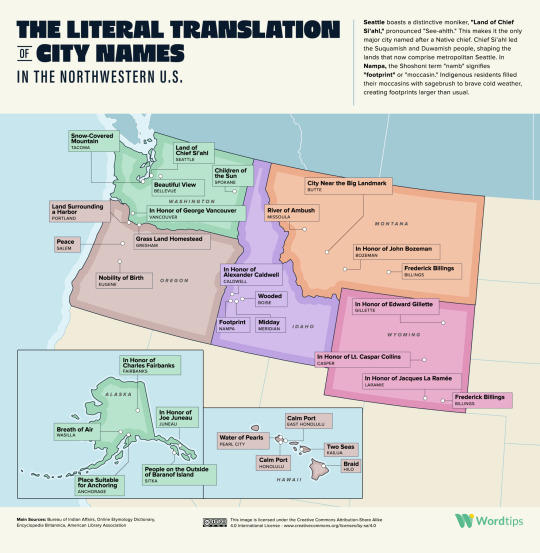
Meanwhile, Boise, Idaho, takes its name from the French word for ‘wooded area.’ However, the name’s origins are influenced by English as well: fur traders passing through the region called it the Wooded River, a name later translated by French trappers.
When surveying the area in the 1830s, the French United States Army officer B.L.E. Bonneville had the final say, choosing French over English.
The Literal Meanings Behind Major City Names in the Southwestern U.S.
Many major cities in the Southwestern U.S. bear names that honor notable individuals. Reno, for instance, pays tribute to Jesse Lee Reno, a Virginia-born Union general who met his demise during the battle of Fox’s Gap. The official announcement regarding the city’s naming stated:
“The name of the new town on the C.P.R.R. at the junction of the contemplated branch road to Virginia City in Nevada, is Reno, in honor of General Reno, who fell gloriously fighting in defense of the flag against the assault of traitors in rebellion.”
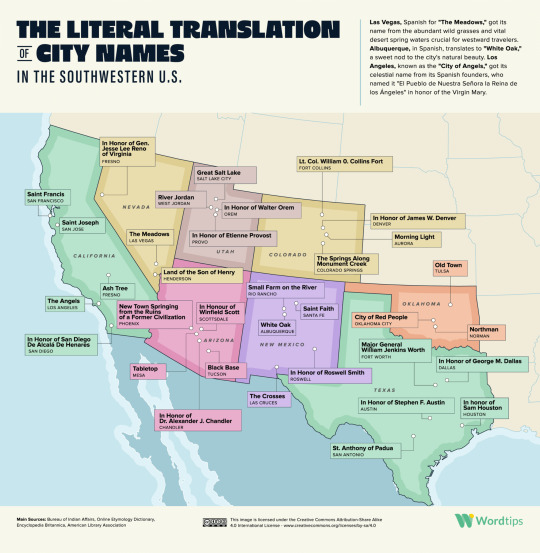
Similarly, Orem, Utah, derives its name from Walter Orem, a prominent figure in mining and railroad development who constructed the state’s inaugural electric railroad. However, the town’s naming was more an act of flattery than gratitude towards Orem’s contributions. In 1919, as the town faced a critical juncture in its expansion efforts, requiring investment for incorporation and the establishment of a networked water system, it was named after Orem in hopes of securing his support. Prior to this, the area had been known as Provo Bench.
The Literal Meanings Behind Major City Names in the Southeastern U.S.
In September 1687, Henri Joutel noted in his writings: “We arrived at the said place called Chicagou which, according to what we were able to learn of it, has taken this name because of the quantity of garlic which grows in the forests in this region.”
Other accounts suggest that the name Chicago may have originated from the Algonquian word sheka:ko:heki, meaning “place of the wild onion,” or possibly from the Ojibwa word for skunk. Regardless of its precise origins, it appears that odor was a prominent characteristic of the area before the establishment of the town of Chicago in 1833.
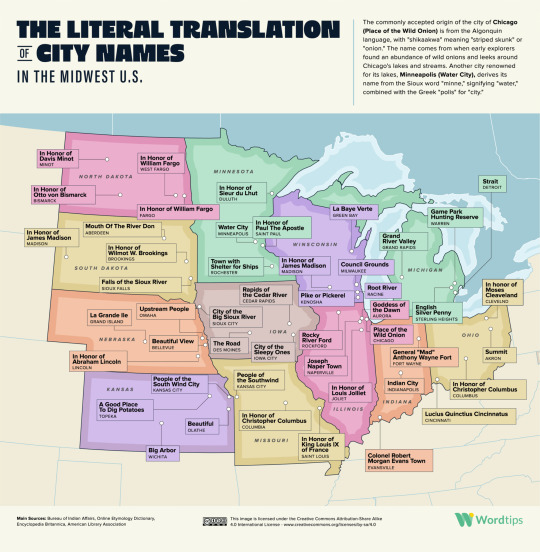
Topeka, on the other hand, translates from the Kansa (Siouan) language as “A Good Place to Dig Potatoes.” The founders chose this name in 1855 with originality in mind. Fry W. Giles, a banker and city founder, described Topeka as “a name not found in the list of post offices of the United States, nor in any lexicon of the English language. It was novel, of Indian origin, and euphonious of sound.”
The Literal Meanings of Major City Names in the Southeastern U.S.
Understanding that Baton Rouge means “red stick” doesn’t require fluency in French. But why was Louisiana named “red stick”? In 1699, French explorer Pierre Le Moyne d’Iberville stumbled upon the area and spotted a reddened pole adorned with sacrificial fish and bear heads by the Native inhabitants. This visual left an impression on d’Iberville, leading him to refer to the area as Baton Rouge when the French colonized it.
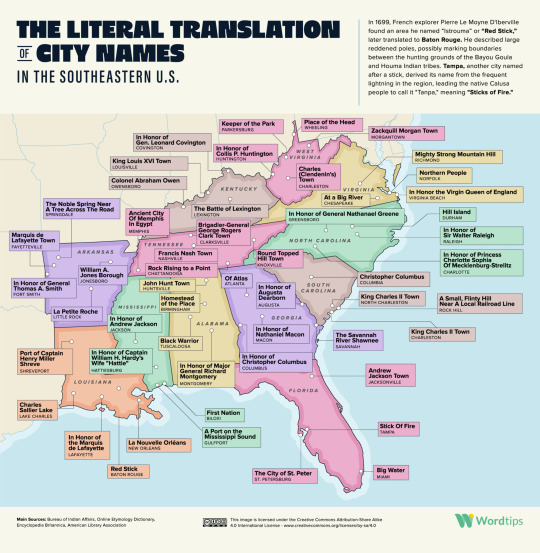
Among the most intriguing place names in the study is Memphis. The city took its name from the ancient Egyptian city of Memphis, which translates to “enduring and beautiful” or “Place of Good Abode,” depending on interpretation. The founders, John Overton, James Winchester, and Andrew Jackson, were less concerned with etymology; they chose the name because both cities stand beside vast rivers.
The Literal Meanings Behind Major City Names in the Northeastern U.S.
Some city name translations in the Northeast are well-known or easy to understand, such as Philadelphia (from the Greek for “brotherly love”) or Portland (the land around a port). Others require a bit more digging.
Would you be able to identify the city name that translates to Botolph’s Stone if it wasn’t labeled on our map? Boston was named after a town in Lincolnshire, England, which, in turn, was named after Botolph, the patron saint of travelers. The second part of the name could derive from “stone” or perhaps from “tun,” the Old English word for village.
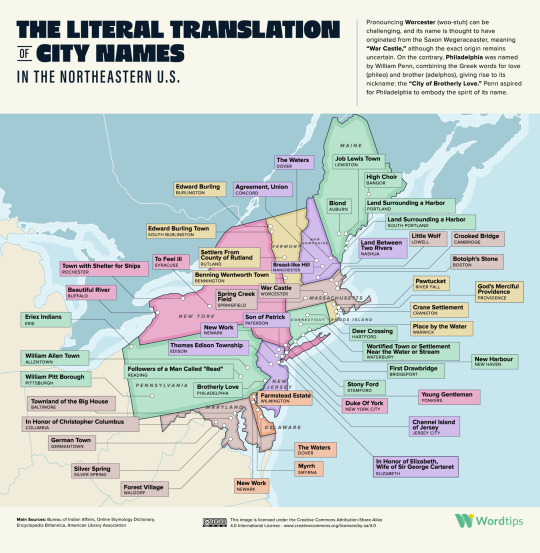
The Dutch colonized New Netherland, which included parts of present-day New York City, Long Island, Connecticut, and New Jersey, with the city of New Amsterdam located on today’s Manhattan Island.
However, in 1664, James II of England, the Duke of York, captured the island, leading to the city receiving its eventual name.
If that sounds odd and European, remember the city was briefly called New Orange when the Dutch briefly recaptured it in 1673.
Methodology:
The WordTips team compiled research from a diverse array of sources, including the Bureau of Indian Affairs, the Online Etymology Dictionary, the Encyclopedia Britannica, the American Library Association, historical records, and regional news reports. The aim was to unveil the literal meanings behind the names of each U.S. state, their respective capital cities, and 178 of the most populated cities scattered across the country.
The investigation delved into various aspects of etymology, considering cases where a state or city was named after a person or significant event, where the words in a location’s name evolved in meaning from an earlier version of English or another language, or according to the significance behind another location after which a U.S. state or city was named.
This project’s research was concluded in January 2024.
3 notes
·
View notes
Text
Don't Be A Halfway Salafi
If you truly want to be a Salafī, you must study the maḏhab al-salaf (ie: way of the predecessors) thoroughly and understand it with baṣīrah (ie: insight), فإذا أردت أن تكون سلفيا حقا فعليك تدرس مذهب السلف بإتقان وتعرفه ببصيرة then practice it without ġulū (ie: extremism) or negligence. ثم تعمل به من غير غلو ومن غير تساهل This is the manhaj al-salaf al-ṣaḥīḥ (ie: correct methodology of the predecessors). هذا هو منهج السلف الصحيح Merely claiming affiliation without genuine adherence is harmful and not beneficial. Yes. أما مجرد الإدعاء والانتساب من غير حقيقة فهذا يضر ولا ينفع. نعم. Ṣāliḥ al-Fawzān, Sharḥ al-Fatāwá al-Ḥamawiyyah al-Kubrá 3/2546 صالح الفوزان، شرح الفتوى الحموية ٣/٢٥٤٦ https://youtu.be/O5Ub1V3HVKw?t=2546s Telegram: https://t.me/aljadwal Tumblr: https://al-jadwal.tumblr.com
6 notes
·
View notes